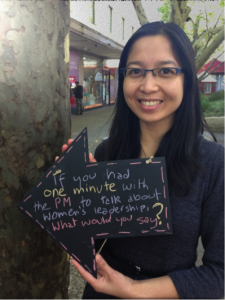she speaks for the future of women’s leadership

By now we’re all too aware that we have an excess of men in leadership across all sectors, industries, government and media. Try this game:
Can you name the seven women who are CEO’s of ASX 200 companies?
Can you name a Breakfast radio program that is hosted by more than one woman?
What’s the name of the Australian Women’s cricket team?
A study from the Geena Davis Institute for Gender in Film has found that female characters in Hollywood feature films populate less than 30 per cent of all speaking roles and comprise only 20.3 per cent of employed characters. A mere 32 per cent of 374 broadcast and print news stories surveyed in 2009 were either written or presented by women. Women in sport make up just 9 per cent of all sports coverage on TV news and current affairs.
Women hold 18.1 per cent of board directorships in the ASX 200, make up 31 per cent of the Federal Parliament and are just 39 per cent of Senior Executive Service positions in the Australian Public Service. Recent media reports into bullying against female local government councillors in NSW has drawn attention to the fact that only 1 in 5 popularly elected mayors is a woman. And, what’s more, in the areas where women are making it to the top, there remains a concerning disjunct between the number of women on the ground and at the top. A case in point is the community sector where 51 per cent of board director roles and 60 per cent of senior management positions are held by women. They’re impressive figures, but when you consider that 85 per cent of the sector’s workforce is female, there is still some way to go.
Male dominance in leadership positions is normalised in such a way that anything else is deemed, as Katy Gallagher put it recently at the World YWCA Round the World Breakfast in Canberra, ‘an interruption to normal programming’. While we need to keep celebrating women’s leadership wins; we should also be aware that when so much of the attention is focussed on the few women in leadership it can work to overshadow the fact that this is the exception rather than the rule.
In spite of all these barriers, it would appear that girls and young women are refusing to limit their own leadership ambitions. We know this because the YWCA She Speaks survey has, for some years now, been recording the views of girls and young women between the ages of 15-30 on leadership.
Last year 77 per cent of the 1655 respondents said they aspired to be leaders in some aspect of their lives. It is increasingly clear girls and young women not only have the energy but the ambition to be leaders; it is up to all of us to make sure the systems are in place to support that.
55 per cent of respondents last year also stated they already considered themselves leaders, as one young woman simply said ‘I believe I have something to offer others and the community.’ This draws our attention to the important question around how we value women’s leadership.
At YWCA we want to explore this idea further. This year’s She Speaks survey includes the question ‘Do you consider yourself a leader in your workplace, educational setting, family, friendship circle and/or community?’ By asking this question, we’re hoping to capture the everyday leadership that girls and young women are exercising make it visible; as Margaret Wheatley says ‘leadership is a series of behaviours rather than a role for heroes.’ Chipping away at the barriers to women’s leadership will only be effective if we start broadening how we define leadership so that it captures the experiences girls and young women.
The voices of girls and young women hold the key to a future where women’s leadership is nurtured, valued and realised. She Speaks harnesses those voices and turns them into a blueprint for this future. So, give yourself the time to reflect on what leadership means and contribute to advocacy for girls and young women by adding your voice to She Speaks.
Hannah Gissane is a Project Co-ordinator for YWCA Australia.

